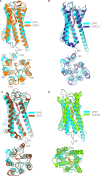Lipid-Dependent Activation of the Orphan G Protein-Coupled Receptor, GPR3
- PMID: 38376112
- PMCID: PMC10919283
- DOI: 10.1021/acs.biochem.3c00647
Lipid-Dependent Activation of the Orphan G Protein-Coupled Receptor, GPR3
Abstract
The class A orphan G protein-coupled receptor (GPCR), GPR3, has been implicated in a variety of conditions, including Alzheimer's and premature ovarian failure. GPR3 constitutively couples with Gαs, resulting in the production of cAMP in cells. While tool compounds and several putative endogenous ligands have emerged for the receptor, its endogenous ligand, if it exists, remains a mystery. As novel potential drug targets, the structures of orphan GPCRs have been of increasing interest, revealing distinct modes of activation, including autoactivation, presence of constitutively activating mutations, or via cryptic ligands. Here, we present a cryo-electron microscopy (cryo-EM) structure of the orphan GPCR, GPR3 in complex with DNGαs and Gβ1γ2. The structure revealed clear density for a lipid-like ligand that bound within an extended hydrophobic groove, suggesting that the observed "constitutive activity" was likely due to activation via a lipid that may be ubiquitously present. Analysis of conformational variance within the cryo-EM data set revealed twisting motions of the GPR3 transmembrane helices that appeared coordinated with changes in the lipid-like density. We propose a mechanism for the binding of a lipid to its putative orthosteric binding pocket linked to the GPR3 dynamics.
Conflict of interest statement
The authors declare the following competing financial interest(s): P.M.S. is a co-founder and shareholder of Septerna Inc. and DACRA Tx. D.W. is a shareholder in Septerna Inc. and co-founder and shareholder of DACRA Tx. M.M.F. is an employee of AstraZeneca.
Figures




References
-
- Sveidahl Johansen O.; Ma T.; Hansen J. B.; Markussen L. K.; Schreiber R.; Reverte-Salisa L.; Dong H.; Christensen D. P.; Sun W.; Gnad T.; Karavaeva I.; Nielsen T. S.; Kooijman S.; Cero C.; Dmytriyeva O.; Shen Y.; Razzoli M.; O’Brien S. L.; Kuipers E. N.; Nielsen C. H.; Orchard W.; Willemsen N.; Jespersen N. Z.; Lundh M.; Sustarsic E. G.; Hallgren C. M.; Frost M.; McGonigle S.; Isidor M. S.; Broholm C.; Pedersen O.; Hansen J. B.; Grarup N.; Hansen T.; Kjær A.; Granneman J. G.; Babu M. M.; Calebiro D.; Nielsen S.; Rydén M.; Soccio R.; Rensen P. C. N.; Treebak J. T.; Schwartz T. W.; Emanuelli B.; Bartolomucci A.; Pfeifer A.; Zechner R.; Scheele C.; Mandrup S.; Gerhart-Hines Z. Lipolysis drives expression of the constitutively active receptor GPR3 to induce adipose thermogenesis. Cell 2021, 184, 3502–3518. 10.1016/j.cell.2021.04.037. - DOI - PMC - PubMed
-
- Huang Y.; Rafael Guimarães T.; Todd N.; Ferguson C.; Weiss K. M.; Stauffer F. R.; McDermott B.; Hurtle B. T.; Saito T.; Saido T. C.; MacDonald M. L.; Homanics G. E.; Thathiah A. G protein–biased GPR3 signaling ameliorates amyloid pathology in a preclinical Alzheimer’s disease mouse model. Proc. Natl. Acad. Sci. U. S. A. 2022, 119, e220482811910.1073/pnas.2204828119. - DOI - PMC - PubMed
Publication types
MeSH terms
Substances
LinkOut - more resources
Full Text Sources
Research Materials

